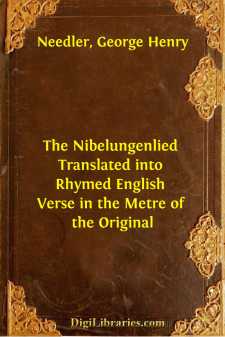Categories
- Antiques & Collectibles 13
- Architecture 36
- Art 48
- Bibles 22
- Biography & Autobiography 813
- Body, Mind & Spirit 142
- Business & Economics 28
- Children's Books 15
- Children's Fiction 12
- Computers 4
- Cooking 94
- Crafts & Hobbies 4
- Drama 346
- Education 46
- Family & Relationships 57
- Fiction 11829
- Games 19
- Gardening 17
- Health & Fitness 34
- History 1377
- House & Home 1
- Humor 147
- Juvenile Fiction 1873
- Juvenile Nonfiction 202
- Language Arts & Disciplines 88
- Law 16
- Literary Collections 686
- Literary Criticism 179
- Mathematics 13
- Medical 41
- Music 40
- Nature 179
- Non-Classifiable 1768
- Performing Arts 7
- Periodicals 1453
- Philosophy 64
- Photography 2
- Poetry 896
- Political Science 203
- Psychology 42
- Reference 154
- Religion 513
- Science 126
- Self-Help 84
- Social Science 81
- Sports & Recreation 34
- Study Aids 3
- Technology & Engineering 59
- Transportation 23
- Travel 463
- True Crime 29
The Nibelungenlied Translated into Rhymed English Verse in the Metre of the Original
Categories:
Description:
Excerpt
1. Origin of the Saga
All the Aryan peoples have had their heroic age, the achievements of which form the basis of later saga. For the Germans this was the period of the Migrations, as it is called, in round numbers the two hundred years from 400 to 600, at the close of which we find them settled in those regions which they have, generally speaking, occupied ever since. During these two centuries kaleidoscopic changes had been taking place in the position of the various Germanic tribes. Impelled partly by a native love of wandering, partly by the pressure of hostile peoples of other race, they moved with astonishing rapidity hither and thither over the face of Europe, generally in conflict with one another or buffeted by the Romans in the west and south, and by the Huns in the east. In this stern struggle for existence and search for a permanent place of settlement some of them even perished utterly; amid the changing fortunes of all of them deeds were performed that fixed themselves in the memory of the whole people, great victories or great disasters became the subject of story and song. We need only to recall such names as those of Ermanric and Theodoric to remind ourselves what an important part was played by the Germanic peoples of that Migration Period in the history of Europe. During it a national consciousness was engendered, and in it we have the faint beginnings of a national literature. Germanic saga rests almost entirely upon the events of these two centuries, the fifth and sixth. Although we get glimpses of the Germans during the four or five preceding centuries, none of the historic characters of those earlier times have been preserved in the national sagas.
With these sagas based on history, however, have been mingled in most cases primeval Germanic myths, possessions of the people from prehistoric times. A most conspicuous example of this union of mythical and originally historical elements is the Nibelungen saga, out of which grew in course of time the great national epic, the Nibelungenlied.
The Nibelungen saga is made up of two parts, on the one hand the mythical story of Siegfried and on the other the story, founded on historic fact, of the Burgundians. When and how the Siegfried myth arose it is impossible to say; its origin takes us back into the impenetrable mists of the unrecorded life of our Germanic forefathers, and its form was moulded by the popular poetic spirit. The other part of the saga is based upon the historic incident of the overthrow of the Burgundian kingdom by the Huns in the year 437. This annihilation of a whole tribe naturally impressed itself vividly upon the imagination of contemporaries. Then the fact of history soon began to pass over into the realm of legend, and, from causes which can no longer be determined, this tradition of the vanished Burgundians became united with the mythical story of Siegfried. This composite Siegfried-Burgundian saga then became a common possession of the Germanic peoples, was borne with many of them to lands far distant from the place of its origin, and was further moulded by each according to its peculiar genius and surroundings....


